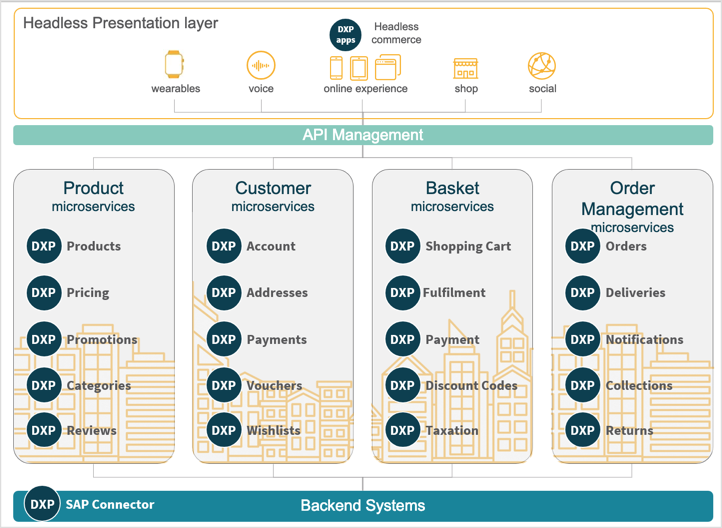Case Study: Decoupled/Headless Stack
Enterprise organisations look to navigate effectively today’s complex modern technology landscape. In their desire to decouple their workload and increase vendor independence they find themselves gravitating towards one of the following solutions:
-
API led, representing their business processes and services.
-
Microservices based, deploying fleets of atomic workloads that are easy to design and run.
-
Cloud-native, leverage infrastructure and PaaS services as a utility.
-
SaaS driven, at scale integrating commoditized services at a low cost
-
Headless approach to their presentation layer and in particular ECommerce.
The goal of the above is to break the re-platforming cycle that ensues every few years with monolithic, strongly coupled systems delivering online commerce. Neptune DXP is ideally positioned to be a key component in the delivery of such a modern IT practice. Let’s see how:

In this stack the customer experience is implemented using a fit for purpose UI for each channel:
-
Online orders are serviced by a headless commerce frontend fed by headless Content Management System (CMS).
-
Neptune DXP mobile and web apps may be the platform of choice for in store corporate apps allowing interactions with customers when inquiring for products or collecting their orders .
-
Wearable apps may be implemented using native frameworks to track order status.
-
Voice communications using a telephony specific solution along with machine learning SaaS services may be used to transcribe conversations and synthesize responses (text-to-voice)
-
Social feeds are aggregated by a real-time social management system to track sentiment and requests for information or order status tracking.
The above frontend elements implementing the customer experience are supported by a catalogue of enterprise APIs exposed by an API management layer. The exposed APIs are serviced by a comprehensive network of business services implemented by Neptune DXP microservices. An indicative set of Neptune DXP services bound by contexts, such as product, customer, basket, and order management services may be launched with most of them abstracting backend functions in legacy ERP systems that still act as the system of record.
For example, an order placed by a Neptune DXP application or the headless ecommerce frontend is processed by the Order API which relies on a Neptune DXP orders microservice for its implementation. In turn the orders microservice creates a customer order in an SAP S/4 Hana system via the Neptune DXP SAP connector.
The fundamental takeaway from this approach is that the:
-
Presentation layer is agnostic to the business services used to deliver the queries and actions initiated by customers, employees, and partners. The presentation layer no longer attempts to implement any form of business logic and instead delegates this to a set of Enterprise APIs.
-
API Management produces a façade of well-formed APIs to expose business competencies ultimately implemented by a nebula of Neptune DXP microservices. The APIs are agnostic to the consumers accessing their functions and make no distinction between different channels (online, in-store,…).
-
Microservices orchestrate the multitude of legacy ERP systems along with SaaS services or indeed act as the new system of record for some data loads to compose and serve responses to API requests. Despite servicing the Enterprise APIs published by the API management layer they are agnostic to its existence.
-
Backend/SaaS systems are similarly agnostic to the presence of the microservices layer and continue to provide the same breadth of services as they have always done. For SAP systems this abstraction is achieved by the Neptune DXP SAP connector, which wraps SAP traditional methods of communication around a REST API obfuscating and decoupling the originating callers to its resources.
With all the component elements of this stack being de-coupled from one another we can replace them at will without worrying about cascading failures due to brittle interdependencies. As a result, the technology landscape is flexible and can evolve with increased velocity. It is also more agile allowing the introduction of new components to leverage emerging technologies, such as democratised AI/ML services.